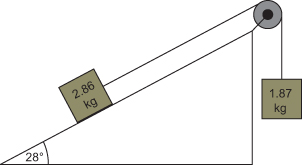 |
| 1 |  | 
Resolve the velocity 6.4 m/s [N28.00W] into its components. |
|  | A) | 3.00 m/s[N] and 5.65 m/s[W] |
|  | B) | 3.40 m/s[N] and 5.40 m/s [W] |
|  | C) | 5.65 m/s[N] and 3.00 m/s[W] |
|  | D) | - 5.65 m/s[N] and – 3.00 m/s [W] |
|
|
 |
| 2 |  | 
Three forces, 58 N[W], 72N [N520E], and 32 N[S260W] act on a 58 kg mass. What is the acceleration of the mass? |
|  | A) | 1.7 m/s2 [NW] |
|  | B) | 0.38 m/s2 [N440E] |
|  | C) | 0.38 m/s2 [N440W] |
|  | D) | 0.53 m/s2 [N440W] |
|
|
 |
| 3 |  | 
A 52.0 kg crate sits on an incline. What is the minimum angle between the incline and the horizontal that will cause the crate to start sliding if the coefficient of friction is 0.280? |
|  | A) | 560 |
|  | B) | 18.40 |
|  | C) | 23.60 |
|  | D) | 15.60 |
|
|
 |
| 4 |  | 
An elevator is accelerating upwards at 0.860 m/s2. If the total mass of elevator and occupants is 2862 kg, what is the tension in the cable? |
|  | A) | 2.56 x 104 N[up] |
|  | B) | 3.05 x 104 N[up] |
|  | C) | 2.81 x 104 N[up] |
|  | D) | 2.81 x 104 N[down] |
|
|
 |
| 5 |  | 
The tension in the rope of an Atwood machine is 628 N. If the larger mass is 72.0 kg, what is the other mass? |
|  | A) | 70.9 kg |
|  | B) | 64.0 kg |
|  | C) | 48.3 kg |
|  | D) | 57.6 kg |
|
|
 |
| 6 |  | 
 <a onClick="window.open('/olcweb/cgi/pluginpop.cgi?it=jpg::::/sites/dl/free/0070922802/536439/pei_physics_Ch10_quiz1_question6.jpg','popWin', 'width=NaN,height=NaN,resizable,scrollbars');" href="#"><img valign="absmiddle" height="16" width="16" border="0" src="/olcweb/styles/shared/linkicons/image.gif"> (50.0K)</a>. A block of mass 2.86 kg sits on a slope that makes an angle of 280 to the horizontal. The block is connected by a cord (which passes over a pulley) to a second mass of 1.87 kg which hangs freely. If the coefficient of friction between the first block and the incline is 0.14, what is the acceleration of the masses? <a onClick="window.open('/olcweb/cgi/pluginpop.cgi?it=jpg::::/sites/dl/free/0070922802/536439/pei_physics_Ch10_quiz1_question6.jpg','popWin', 'width=NaN,height=NaN,resizable,scrollbars');" href="#"><img valign="absmiddle" height="16" width="16" border="0" src="/olcweb/styles/shared/linkicons/image.gif"> (50.0K)</a>. A block of mass 2.86 kg sits on a slope that makes an angle of 280 to the horizontal. The block is connected by a cord (which passes over a pulley) to a second mass of 1.87 kg which hangs freely. If the coefficient of friction between the first block and the incline is 0.14, what is the acceleration of the masses? |
|  | A) | 0.63 m/s2 |
|  | B) | 0.36 m/s2 |
|  | C) | 0.91 m/s2 |
|  | D) | 4.8 m/s2 |
|
|
 |
| 7 |  | 
A painter of mass 74 kg stands three quarters of the way up a 6.0 m ladder that is leaning at a 620 angle to the horizontal against a smooth wall. If the ladder has a mass of 42 kg, what must be the coefficient of static friction between the ladder and the ground so that the ladder will not slip. Assume that friction between the ladder and the wall is zero. |
|  | A) | 0.35 |
|  | B) | 0.54 |
|  | C) | 0.38 |
|  | D) | 0.19 |
|
|
 |
| 8 |  | 
An object is in static equilibrium if |
|  | A) | The vector sum of all of the forces acting on it is zero, and if the sum of all of the torques acting on it is zero. |
|  | B) | The vector sum of all of the forces acting on it is zero, or if the sum of all of the torques acting on it is zero. |
|  | C) | The vector sum of all of the forces acting on it is equal but opposite to, the sum of all of the torques acting on it. |
|  | D) | The vector sum of all of the forces acting on it is zero. |
|
|
 |
| 9 |  | 
In a collision |
|  | A) | Kinetic energy is always conserved |
|  | B) | Kinetic energy is only conserved in an inelastic collision |
|  | C) | Momentum is always conserved, and kinetic energy is conserved if the collision is elastic. |
|  | D) | Momentum is only conserved if the collision is elastic |
|
|
 |
| 10 |  | 
A billiard ball of mass 0.186 kg, moving east with a velocity of 1.86 m/s, collides head-on with a stationary marble ball of mass 0.428 kg. What will be the final velocity of each of the balls if the collision is perfectly elastic? |
|  | A) | The billard ball will rebound at 0.733 m/s[W] and the marble ball continues on at 1.13 m/s[E] |
|  | B) | The billard ball will continue on at 0.733 m/s[E] and the marble ball continues on at 1.13 m/s[E] |
|  | C) | The billard ball will continue on at 1.13 m/s[E] and the marble ball continues on at 1.86 m/s[E] |
|  | D) | The billiard ball stops, and the marble ball continues on at 1.86 m/s[E] |
|
|

